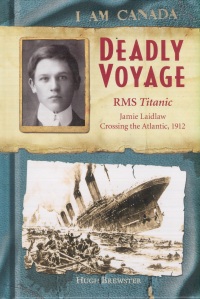| ________________
CM . . . . Volume XVIII Number 7 . . . . October 14, 2011
excerpt:
The Titanic was the biggest, the best, the unsinkable, and on its maiden voyage from Southampton to New York in 1912, it was full of the richest, most famous of the upper-class English-speaking world as well as a number of Irish emigrants and others. No wonder her fascination for newspapers and people in general before, after, and long after her collision with an iceberg and her sinking in the North Atlantic. She did not go down "with all hands", but only about a third of those aboard were saved. Hugh Brewster, a Titanic scholar and author of several books on the subject, has written a gripping account of the disaster as seen through the eyes of young Jamie Laidlaw. Jamie, his parents, his mother's maid, and his dog, were all first-class passengers on the Titanic. Yes, the dog, too. There was special kennel accommodation for the pets of passengers on board the ship. (Query: the dogs were exercised on the deck, as they would have to be, either by their owners or by one of the crew, but no mention is made of either the necessity of 'scooping', or of the propensity of male dogs to mark their territory.) The details of the luxurious furnishings, the elaborate food, and the many facilities for the comfort and entertainment of the passengers are all indicated, particularly as most of them--other than the food--were not designed primarily with teen-aged boys in mind.
Then came the crunch and the incredible debacle of the launching of lifeboats only half-full, in spite of there not being enough spaces, even if they had been fully loaded, to accommodate all the passengers. All the named passengers in the book, other than the Laidlaws, are actual people who were present on the ship, their stories and their fates known. This fact gives the whole book an authenticity that imaginary characters, however, well-drawn, could not have. It also lends credence to an apparent deduction about one John Ryerson, a young survivor of the sinking who had been travelling back to New York with his family after the tragic death of his older brother in a car accident in France. In the Author's Note at the end of the book, Brewster says that John "refused to speak of the disaster" for many years afterwards, and, in the story, there are repeated suggestions that he had dressed as a girl in order to get onto one of the lifeboats. Certainly, it would have been both shameful and cowardly to have done such a thing. Highly Recommended. Mary Thomas lives in Winnipeg, MB, and the one time she travelled by ship across the North Atlantic, the life-boat drill seemed a bit of a farce. Obviously it isn't always!
To comment
on this title or this review, send mail to cm@umanitoba.ca.
Copyright © the Manitoba Library Association. Reproduction for personal
use is permitted only if this copyright notice is maintained. Any
other reproduction is prohibited without permission.
NEXT REVIEW |
TABLE OF CONTENTS FOR THIS ISSUE
- October 14, 2011.
AUTHORS |
TITLES |
MEDIA REVIEWS |
PROFILES |
BACK ISSUES |
SEARCH |
CMARCHIVE |
HOME |
